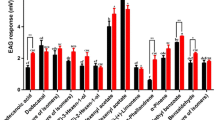Abstract
Volatile chemicals emanating from an excretion (apparently meconium) and abdominal tips of femaleHeliothis zea (Boddie) moths mediated increased rates of parasitization ofH. zea eggs byTrichogramma pretiosum Riley. A blend of synthetic chemicals, consisting of hexadecanal, (Z)-7-hexadecenal, (Z)-9-hexadecenal, and (Z)-11-hexadecenal, which has been identified as the sex pheromone of and from the abdominal tip of femaleH. zea moths, also increased rates of parasitization ofH. zea eggs byT. pretiosum in greenhouse experiments. In addition, parasitization ofH. zea eggs by wildTrichogramma spp., in field plots of cotton,Gossypium hirsutum L., treated with a similar blend of chemicals, in Conrel fibers, was more than double that in untreated plots.
Similar content being viewed by others
References
Altieri, M.A., Lewis, W.J., Nordlund, D.A., Gueldner, R.C., andTodd, J.W. 1981. Chemical interactions between plants andTrichogramma sp. wasp in soybean fields.Prot. Ecol. 3:259–263.
Beevers, M., Lewis, W.J., Gross, H.R., Jr., andNordlund, D.A. 1981. Kairomones and their use for management of entomophagous insects: X. Laboratory studies on manipulation of host finding behavior ofTrichogramma pretiosum Riley with a kairomone extracted fromHeliothis zea (Boddie) moth scales.J. Chem. Ecol. 7:635–648.
Burton, R.L. 1969. Mass rearing the corn earworm in the laboratory. USDA-ARS 33–134.
Carpenter, J.E.,Sparks, A.N., andGueldner, R.C. 1981. Effects of moth population density and pheromone concentration on mating disruption of the corn earworm in large screened cages.J. Econ. Entomol. In press.
Corbet, S.A. 1971. Mandibular gland secretion of larvae of the flour moth,Anagasta kuehniella, contains an epideictic pheromone and elicits oviposition movements in a hymenopteran parasite.Nature 232:481–484.
Gross, H.R., Jr., Lewis, W.J., Jones, R.L., andNordlund, D.A. 1975. Kairomones and their use for management of entomophagous insects: III. Stimulation ofTrichogramma achaeae, T. pretiosum, andMicropletis croceipes with host seeking stimuli at time of release to improve their efficiency.J. Chem. Ecol. 1:431–438.
Heath R.R., andSonnet, P.E. 1980. Technique for in situ coating of Ag+ onto silica gel in HPLC columns for the separation of geometrical isomers.J. Liquid Chromatogr. 3:1129–1135.
Kennedy, B.H. 1979. The effect of multilure on parasites of the European elm bark beetle,Scolytus multistriatus.Bull. Entomol. Soc. Am. 25:116–118.
Klun, J.A., Plimmer, J.R., Bierl-Leonhardt, B.A., Sparks, A.N., Primiani, M., Chapman, O.L., Lee, G.H., andLepone, G. 1980. Sex pheromone chemistry of female corn earworm moth,Heliothis zea.J. Chem. Ecol. 6:165–175.
Laing, J. 1937. Host-finding by parasites. I. Observations on the finding of hosts byAlysia manducator, Mormoniella vitripennis, andTrichogramma evanescens.J. Anim. Ecol. 6:298–317.
Lewis, W.J., andRedlinger, L.M. 1969. Suitability of eggs of the almond moth,Cadra cautella, of various ages for parasitism byTrichogramma evanescens.Am. Entomol. Soc. Am. 62:1482–1484.
Lewis, W.J., Sparks, A.N., andRedlinger, L.M. 1971. Moth odor: A method of host-finding byTrichogramma evanescens.J. Econ. Entomol. 64:557–558.
Lewis, W.J., Jones, R.L., andSparks, A.N. 1972. A host-seeking stimulant for the egg parasite,Trichogramma evanescens. Its source and demonstration of its laboratory and field activity.Ann. Entomol. Soc. Am. 65:1087–1089.
Lewis, W.J., Jones, R.L., Nordlund, D.A., andGross, H.R., Jr. 1975. Kairomones and their use for management of entomophagous insects: II. Mechanisms causing increase in the rates of parasitization byTrichogramma spp.J. Chem. Ecol. 1:349–360.
Lewis, W.J., Beevers, M., Nordlund, D.A., Gross, H.R., Jr., andHagen, K.S. 1979. Kairomones and their use for management of entomophagous insects: IX. Investigations of various kairomone-treatment patterns forTrichogramma spp.J. Chem. Ecol. 5:673–680.
Mitchell, W.C., andMau, R.F.L. 1971. Response of the female southern green stinkbug and its parasite,Trichopoda pennipes, to male stink bug pheromone.J. Econ. Entomol. 64:856–859.
Nordlund, D.A., Lewis, W.J., Gross, H.R., Jr., andHarrell, E.A. 1974. Description and evaluation of a method for field application ofHeliothis zea eggs and kairomones forTrichogramma.Environ. Entomol. 3:981–984.
Nordlund, D.A., Lewis, W.J., Jones, R.L., andGross, H.R., Jr. 1976. Kairomones and their use for management of entomophagous insects: IV. Effect of kairomones on productivity and longevity ofTrichogramma pretiosum Riley (Hymenoptera: Trichogrammatidae).J. Chem. Ecol. 2:67–72.
Oatman, E.R., Platner, G.R., andGonzalez, D. 1970. Reproductive differentiation ofTrichogramma pretiosum, T. semifumatum, T. minutum, andT. evanescens, with notes on the geographic distribution ofT. pretiosum in the southwestern United States and Mexico (Hymenoptera: Trichogrammatidae).Ann. Entomol. Soc. Am. 63:633–635.
Rice, R.E. 1969. Response of some predators and parasites ofIps confusus (Lec.) (Coleoptera: Scolytidae) to olfactory attractants.Contrib. Boyce Thompson Inst. 24:189–194.
Sternlicht, M. 1973. Parasitic wasps attracted by the sex pheromone of their coccid host.Entomophaga 18:339–342.
Teal, P.E. A.,Heath, R.R.,Tumlinson, J.H., andMclaughlin, J.R. 1981. Identification of a sex pheromone ofHeliothis subflexa (Gn.) and field trapping studies using different blends of components.J. Chem. Ecol. In press.
Vité, J.P., andWilliamson, D.L. 1970.Thanasimus dubius: Prey perception.J. Insect Physiol. 16:233–237.
Author information
Authors and Affiliations
Additional information
Hymenoptera: Trichogrammatidae.
Lepidoptera: Noctuidae.
In cooperation with the University of Georgea College of Agriculture Experiment Stations, Coastal Plain Station, Tifton, Georgia 31793.
Mention of a proprietary product does not constitute endorsement by the USDA.
Rights and permissions
About this article
Cite this article
Lewis, W.J., Nordlund, D.A., Gueldner, R.C. et al. Kairomones and their use for management of entomophagous insects. J Chem Ecol 8, 1323–1331 (1982). https://doi.org/10.1007/BF00987765
Received:
Revised:
Issue Date:
DOI: https://doi.org/10.1007/BF00987765




